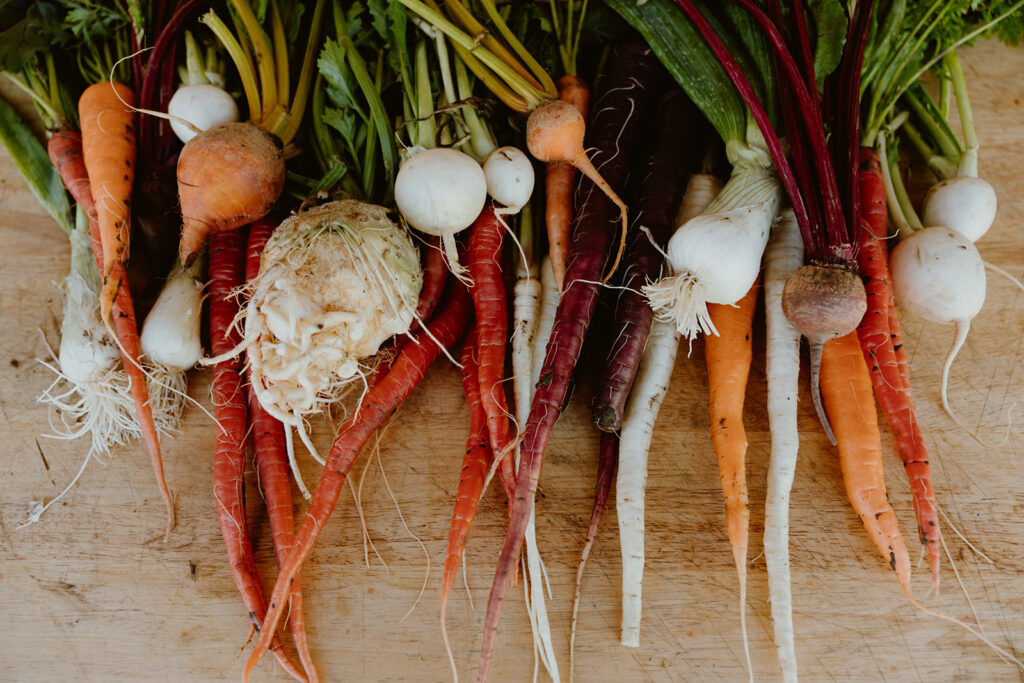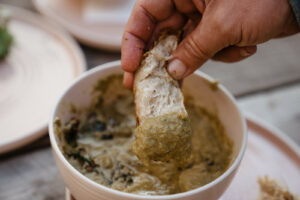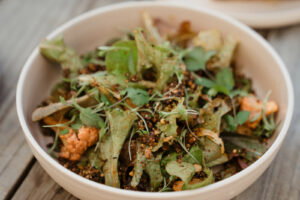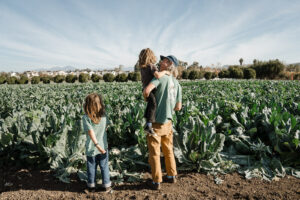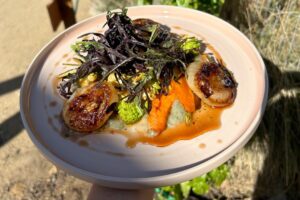Alliums
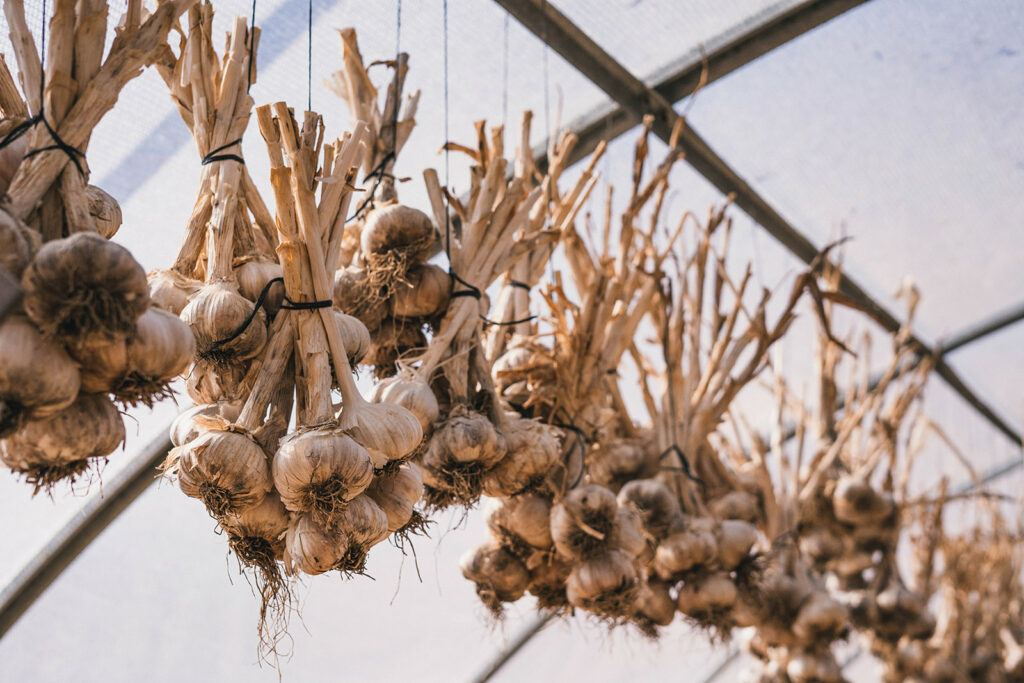
One of the world’s oldest food sources, vegetables in the allium family include all varieties of onions, as well as garlic, leeks, and chives.
SEASONAL IN SOUTHERN CALIFORNIA
PLANT: September through June
HARVEST: January through December
HISTORY
Believed to be a staple of the prehistoric diet, alliums likely originated in the region between central Asia and the Middle East; mysteriously, some varieties are native to North America, as well. Easy to grow, transport, preserve and store, alliums were not only a staple of ancient diets but also a symbol of longevity and the afterlife. Their antimicrobial, antifungal, stimulant and diuretic properties also made alliums useful in early medicine—they are mentioned in texts from Egypt, Greece, India and China as a curative for impotence, scorpion bites, heart disease, lack of energy, and the Black Plague. Spread throughout the Western world by both conquerors and traders, leeks were carried to North America by English settlers, and garlic followed during later waves of European immigration.
PREPARATION
All varieties of alliums come into their own when slowly cooked over low heat, which allows their sugars to caramelize and their fibers to break down. The lighter flavor of shallots and leeks pair well with poultry, pork, eggs, and dairy, while the heavier flavors of onions and garlic complement rich and hearty dishes. Small varieties such as Cipollini and Torpedo onions are delicious when roasted, glazed in balsamic or sherry vinegar, and sprinkled with herbs such as thyme or rosemary. Chopped chives are a bright and piquant garnish for soups, dips, potatoes, egg dishes, fish and other seafood.
COOKING
Finely chop shallots and/or leeks and cook slowly in plenty of olive oil over medium heat, until they are fragrant, broken down, and deep golden-brown in color. Add salt, pepper, and a splash of sherry vinegar, and keep cooking over low heat until liquid has thickened. Toast several slices of crusty bread and spread with goat cheese or ricotta. Spoon shallot/leek mixture over the cheese spread, top with fresh, ripe tomato slices, and sprinkle with chopped chives and, if desired, a pinch of grated lemon zest.
PRO TIPS
If serving alliums raw, soak slices in hot water to mellow their pungency.
Arugula
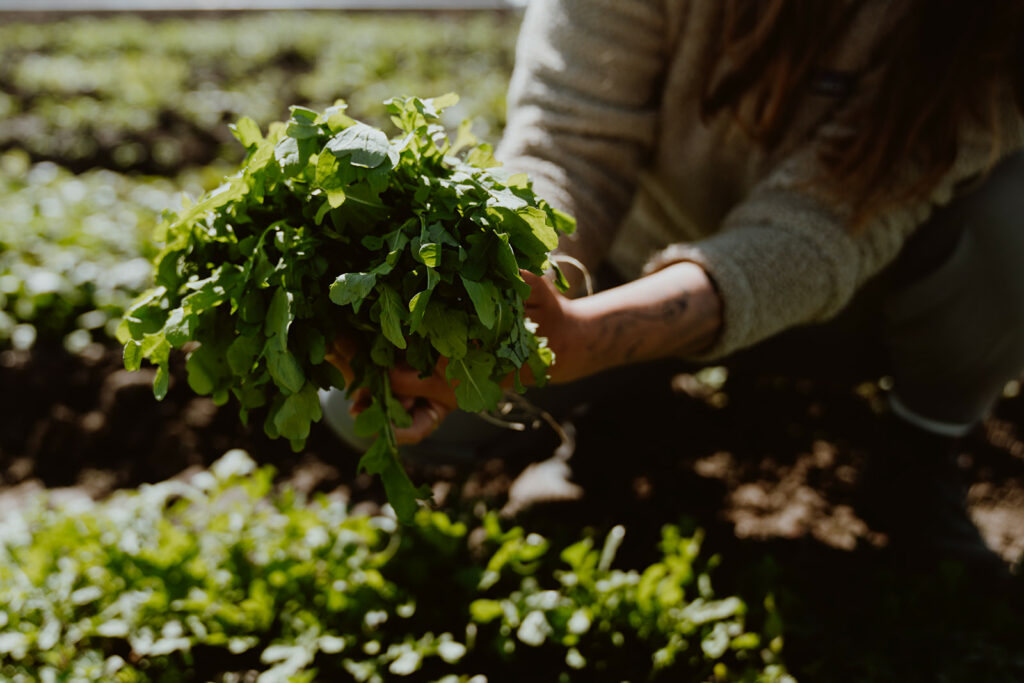
This wild leafy green, also known as “rocket,” was used in Mediterranean kitchens for centuries, yet was relatively unknown to American eaters until the 1990s. As part of the mustard family, it has a peppery bite with both sweet and bitter undertones. This complex flavor, along with the green’s versatility, made arugula an instant hit for home cooks and professional chefs.
SEASONAL IN SOUTHERN CALIFORNIA
PLANT: January through December
HARVEST: January through December
HISTORY
For thousands of years, arugula was widely used for both culinary and medicinal purposes. Along with being used as an anesthetic and as an aphrodisiac, arugula was eaten on a daily basis in Italy and featured in traditional recipes from France to the Middle East. For Jewish groups around the Mediterranean region, arugula was the standard bitter green on Passover plates.
NUTRITION
Arugula is an excellent source of vitamins A, B6, C, and K, as well as folate, calcium, iron, magnesium, phosphorus, potassium, and manganese. Its high nutritional content is linked to diabetes management, cancer and osteoporosis prevention, and cardiovascular health, as well as improving vision, digestion, and immune response.
STORAGE
After rinsing arugula leaves thoroughly, spread on towels or spin until very dry, then pack loosely in a plastic bag with a layer of paper towels to absorb moisture. Arugula will stay fresh in the refrigerator for about a week.
PREPARATION
Arugula is a truly versatile vegetable that can be eaten as a salad green, sauteed like collards or kale, and even used as an herb. While the classic method of serving is with fresh mozzarella and ripe tomatoes, arugula leaves can also be tossed into any stir-fry just before serving, added to pizzas or sandwiches, or substituted for basil in an extra-spicy pesto.
COOKING
Combine arugula with warm roasted or grilled broccoli—toss until arugula is wilted. top with pine nuts, raisins, and shaved Parmesan cheese, and drizzle with a warm dressing of olive oil, lemon juice, and anchovy paste.
PRO TIPS
Younger arugula balances its peppery flavor with a sweeter taste, while more mature leaves have a bitterness similar to dandelion greens.
Asian Greens
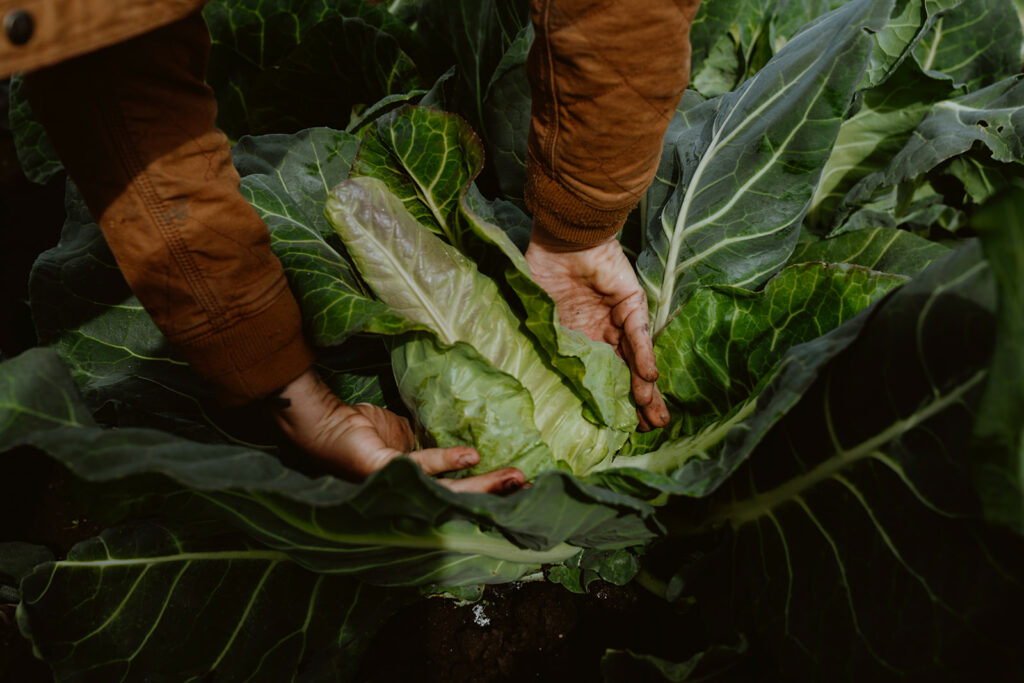
Asian Greens are leafy greens that are commonly used in East and South-East Asian cuisines, have a robust nutrition profile, and are prolific growers.
SEASONAL IN SOUTHERN CALIFORNIA
PLANT: August through December
HARVEST: September through December
HISTORY
Bok choy is native to China, specifically the Yangtze River Delta area. In the 1300s CE, bok choy was imported to Korea, where they created a fermented bok choy dish that is still renown today: kimchi.
The name ‘komatsuna’ means ‘greens of Komatsu’ in Japanese, a reference to the village of Komatsugawa in Edogawa, Tokyo, where it was heavily grown during the Edo period.
Mustard greens are native to India. The first varietal differentiation of mustard greens was cultivated in China near Sichuan. Mustard greens have been naturalized throughout the northern hemisphere from Japan to Europe to South and North America.
Tatsoi is native to China and as it has been cultivated in Japan for so many centuries that it is considered an ancient green.
Tokyo Bekana was developed in Japan from Chinese cabbages brought home by soldiers returning from the Russo-Japanese war in the early 1900s.
NUTRITION
Asian greens are a source of fiber, iron, calcium, manganese, potassium, phosphorus, and vitamins A, C, and K. Most Asian greens supply about 50 percent or more of the Daily Value for vitamin C along with about 10 percent of your daily potassium needs. They are also rich in beta-carotene, an antioxidant that helps maintain skin health and beauty. Because of their lower levels of oxalic acid, the iron and calcium in Asian greens is more readily absorbed than traditional leafy greens such as spinach and silverbeet.
STORAGE
Place your washed and dried Asian greens in a loosely sealed reusable food storage bag in the crisper drawer of your refrigerator. Bok choy and Tokyo Bekana can also be lacto-fermented in a saltwater brine to preserve for four to nine months or more.
PREPARATION
Prepare Asian greens how you would prepare any other leafy green. Common methods of preparation include stir frying with cooking oil or ghee, blanching, steaming, boiling, and pickling. Asian greens can also be used to prepare a nutrient-rich vegetable broth along with any other vegetables of your choice. Serve with soy sauce, liquid aminos, hot sauce, oyster sauce, sesame oil, or any other flavorful sauce as they absorb flavor very easily.
COOKING
Prepare your Asian greens by washing, drying, and chopping or slicing up. Combine vegetable or chicken broth with oyster sauce, cooking wine, soy sauce, honey, and optional salt in a small bowl. Heat a wok on high and add cooking oil to coat. Add freshly diced green onions, ginger, and garlic to the wok and stir fry for 30 seconds. Add greens and stir fry for 2 minutes, pressing greens against the wok and then stirring again. Add the sauce, bring to a boil, cover, and then reduce to simmer for 3 minutes. Add cornstarch or any thickening agent to the mixture and stir for about 15 seconds or until the sauce thickens. Transfer the greens to a plate and serve hot.
PRO TIPS
When cooking Asian greens, separate the stalks and leaves and cook stalks for longer. Found in cuisines throughout Northern and Southern Asia, as suggested by its other names Indian mustard and Chinese mustard. These greens feature broad, frilly leaves with fibrous veins and stems and a strong, assertive taste. Their equally strong-flavored seeds serve as the base for the condiment mustard.
Carrots
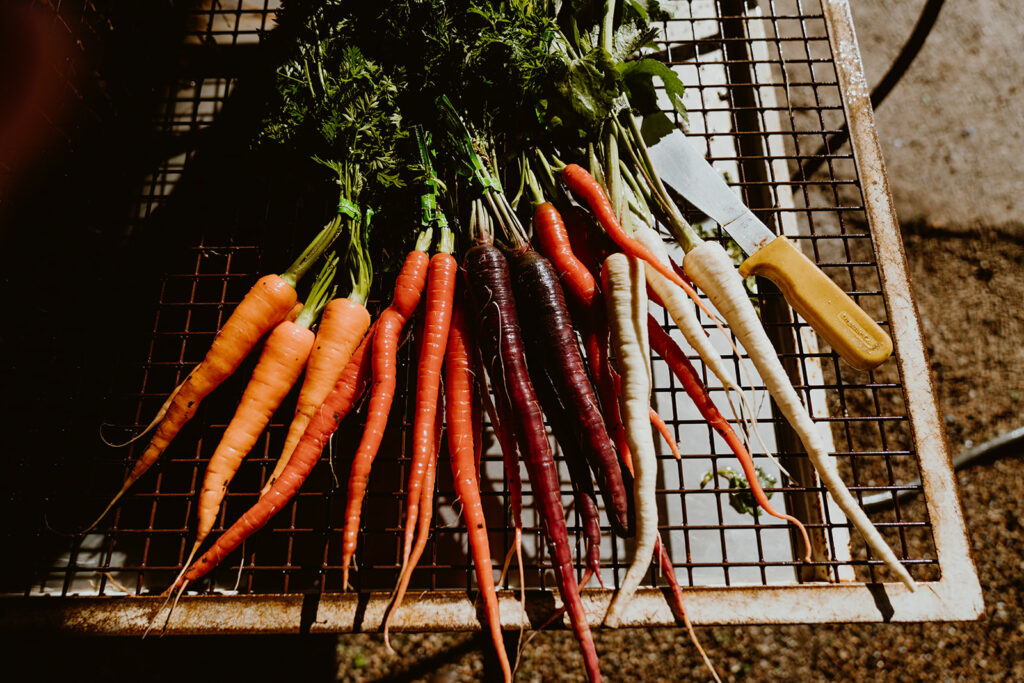
Perhaps the most recognizable vegetable in the world, carrots are known for their kid-friendly sweetness and crunchy texture. While it is prized today for its bright orange root, carrot leaves and seeds offer an herbaceous flavor similar to its related plants such as dill and parsley.
SEASONAL IN SOUTHERN CALIFORNIA
PLANT: September through June
HARVEST: January through December
HISTORY
Domesticated from a wild plant native to Persia, carrots were originally grown for their leaves and seeds. Over time, the plant was selectively bred for a larger taproot, which became popular in the kitchens of ancient Rome and early Europe. Each century spread the carrot farther around the globe, from the Mediterranean and the Middle East to India and China. The orange carrot is fairly new, in terms of the vegetable’s history.
NUTRITION
The bright orange color of carrots comes from a high concentration of beta-carotene, an antioxidant that the human body processes into Vitamin A. Carrots are also rich in vitamin K1, potassium, and fiber.
STORAGE
Snip off leaves about ¼ inch from the top of the carrots, clean off any soil, wrap in a damp cloth or paper towel, and store in an unsealed bag or container in a refrigerator crisper for up to 2 weeks. Avoid cutting the daikon before storing, as the potent smell will spread throughout your refrigerator. Well-dried leaves can be stored for up to a week.
PREPARATION
The bright colors and sweet flavor of carrots have made them a popular choice for every preparation you can imagine. An essential for crudite plates, raw carrots can also be grated, sliced, pickled, and juiced. Their firm texture stands up well to roasting, stewing, frying, or dehydrating. When steamed and mashed, they have a pulpy texture that makes for perfect baby food and is easy to add to baked goods.
COOKING
Peel carrots and chop into bite-size pieces, then add to a large saucepan and cover with water. Simmer until carrots are fork-tender. Add two spoonfuls of butter and two spoonfuls of sugar or another sweetener, along with salt, pepper, and a savory spice mix like vadouvan or garam masala. Cook on low heat, stirring occasionally, until the liquid has thickened into a glaze. Top with finely chopped carrot tops or other herbs, and serve warm.
PRO TIPS
Don’t discard carrot tops. Put cut carrots tops into rice to add color and texture. Upcycle the carrot tops by making a homemade pesto.
Celery
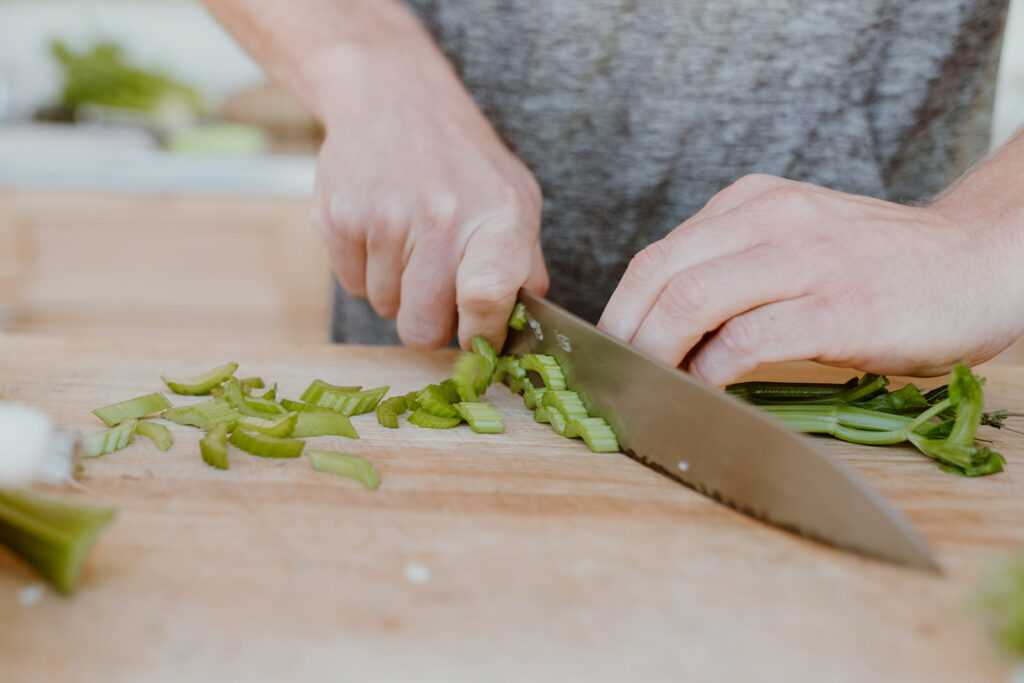
Celery (Apium graveolens) is a marshland plant that has been cultivated as a versatile vegetable with a high fiber content. Depending on location and cultivar, either its stalks, leaves or hypocotyl are eaten and used in cooking. All parts and cultivars of celery are highly nutritious, easy to use in culinary creations, and absorb flavor well.
SEASONAL IN SOUTHERN CALIFORNIA
PLANT: March through November
HARVEST: August through December
HISTORY
Celery is native to the Middle East and Mediterranean areas. Its various traditional and ancient uses include flavoring for Greeks and Romans, medicine in ancient China, and food in France. The modern day version of celery that we are all familiar with was developed in the late 18th century, with fleshy stalks and parsley-like leaves.
NUTRITION
Celery is incredibly rich in fiber, and contains high amounts of antioxidants, flavonoids, and vitamin C. Celery is rich in a phytochemical known as phthalides, a compound known to lead to lower blood pressure. Celeriac, a variety of celery cultivated for its edible root-like stem and shoots, also has a robust nutritional profile. These nutrients include fiber, vitamins B6, C and K, antioxidants, and important minerals. Cutting celery, another cultivar grown for its thinner stalks and leaves, is used medicinally in Ayurveda (ancient Indian healing practice) and is anti-inflammatory.
STORAGE
Wrap a whole, uncut celery in aluminum foil in the crisper drawer of your refrigerator for up to four weeks. Don’t wash or cut until ready to use. To store cut celery stalks, place in a container and submerge with water with a lid for up to two weeks. Replenish the water every couple of days. To store cutting celery, place in a jar with clean water and store in a cool place for up to a week. Celeriac will last several weeks in the fridge, and can also be chopped up and frozen to preserve.
PREPARATION
Celery stalks are incredibly versatile and can be eaten raw or cooked. Common methods of eating raw celery include crudite dishes with dip, chopped up in a salad, or freshly juiced. Popular cooking methods of celery stalks include braising, boiling, stir frying, sautéing, or adding to broths, soups, and stews. Common preparations of cutting celery include cooking in a vegetable stock, making pesto, garnishing with fresh leaves, or adding to a salad. Celeriac, or celery root, is best eaten peeled, sliced, and raw or cooked like any other root vegetable. Celery pairs well with blue cheese, butter, poultry, fish, and other vegetables.
COOKING
Prepare vegetables by washing, chopping, and peeling. Heat olive oil in a large saucepan over medium heat and add one chopped up brown onion. Cook onion until it’s softened, then add celery, celeriac, potato, and garlic. Cook and stir until lightly browned. Increase the heat, add vegetable or chicken stock of your choice, cover, and bring to a boil. Reduce the heat to low and simmer for for 30 minutes or until vegetables are softened. Remove the pan from heat and let cool for a few minutes. Process the soup either in a blender or with a handheld immersion blender in batches until smooth. Then return the soup to a pan over medium heat and stir in pure, grass fed cream. Season with salt and pepper and cook for 5 more minutes, stirring occasionally. Serve in a bowl topped with freshly chopped cutting celery leaves and/or parsley.
PRO TIPS
Celery stalks and celeriac both freeze well. Chop up and freeze on a baking pan for a few hours and transfer to bags to keep frozen for a few months. Blanch celery stalks to freeze for up to 6 months.
Cilantro
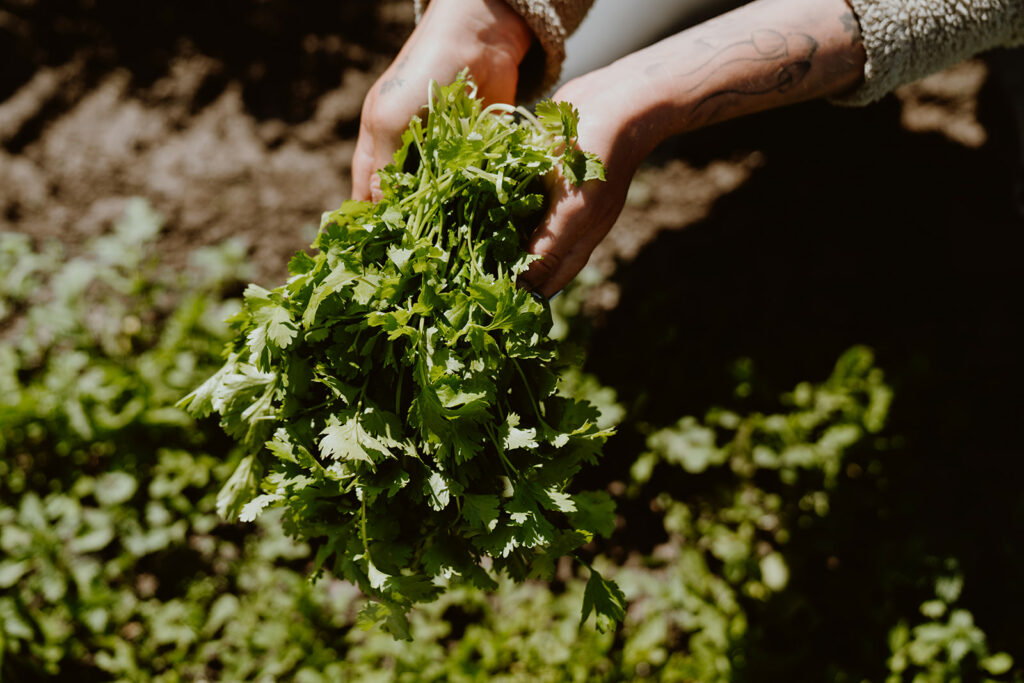
Cilantro, also known as coriander, Mexican parsley or Chinese parsley, is a member of the parsley family, native to the southern Mediterranean. While its taste is a matter of controversy, cilantro’s bright flavor with sage, parsley and citrus notes is indispensable to several beloved global cuisines.
SEASONAL IN SOUTHERN CALIFORNIA
PLANT: September through June
HARVEST: January through December
HISTORY
Cilantro is believed to be one of the first herbs used by humankind, with records of its use as far back as 5000 B.C. Mentioned in early Sanskrit writings, cilantro is a mainstay of Indian and Central Asian cooking; large amounts of the leaves are used to add depth of flavor to cooked dishes, while the seeds are ground for use in the spice blend garam masala. The Romans spread cilantro throughout Europe, and it was one of the first herbs to arrive in the Americas.
NUTRITION
Cilantro is rich in vitamins A, C and K, as well as calcium, potassium, iron, magnesium, and manganese. Cilantro also boasts antibacterial properties and has been used for both insomnia and anxiety relief in traditional medicine.
STORAGE
Cut off the ends of cilantro stems, place in a glass of water, and store in the refrigerator for up to 3 weeks.
COOKING
Delicate cilantro leaves are typically used raw or added to cooked dishes right before serving. Torn fresh cilantro is a bright topping for tacos, enchiladas, and other Mexican dishes, as well as Indian and Thai curries, Moroccan tagine, and a variety of Middle Eastern dishes. It is a welcome addition to condiments such as chutney, salsa, and pesto. Cilantro pairs well with vegetables and fruits such as tomato, avocado, cucumbers, cauliflower, and spinach.
Dandelion
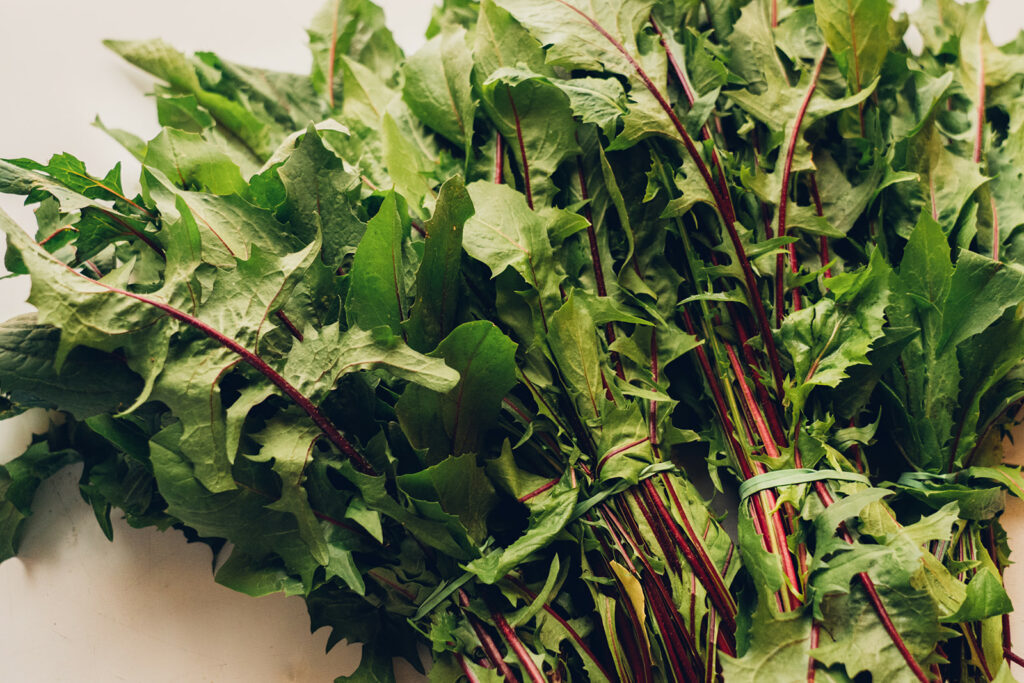
While mainly considered a weed today, dandelion was historically revered as a food with potent health benefits. Their abundant growth and numerous culinary and medicinal uses made them a primary ingredient in everything from stews and salads to pesto, jelly, syrup, and even wine.
SEASONAL IN SOUTHERN CALIFORNIA
PLANT: January through December
HARVEST: January through December
HISTORY
The name of dandelion comes from the French phrase dent de lion, or lion’s tooth, thanks to the leaves’ serrated edges. The plant was also known as pissenlit, or “pee the bed,” thanks to its use as a diuretic. While the plant is native to Eurasia, its aggressive pollination led to it being introduced via European migration to North America, South America, India, and Australia.
NUTRITION
Dandelion is high in vitamins A, C, K and B2, contains more protein and iron than spinach, and includes a sugar compound called taraxacin that stimulates digestion. In traditional Chinese and Native American medicine, dandelion is used to treat stomach and liver conditions, while modern herbalists also use it to heal heartburn, gastrointestinal disorders, inflammation, and diabetes.
STORAGE
Wrap dry dandelion leaves in a lightly dampened paper towel and store in a half-sealed bag in the coldest part of the refrigerator for 3 to 5 days.
PREPARATION
The bittersweet flavor of dandelion leaves is an excellent way to cut the richness of heavier foods like bacon, oily fish, hard cheeses, or avocado. Their bitter flavor also adds dimension to mild flavors such as beans and lentils, grains, and pasta. They are a powerful addition to green juices and smoothies—just make sure to include an apple or grapefruit to help cut the bitterness.
COOKING
Sauté torn dandelion leaves with olive oil and garlic. Transfer to a large bowl, adding lettuce or other greens if desired. Add a scoop of warm white beans, crumbled bacon or pancetta, toasted bread cubes, and a soft poached or fried egg. Toss with more olive oil, salt, and a squeeze of fresh lemon.
PRO TIPS
Taste dandelion greens before using to assess their bitterness. If you find them too bitter, remove stems and blanch greens in a pot of salted boiling water for 1 to 2 minutes, then plunge greens into an ice bath to avoid overcooking.
Dill
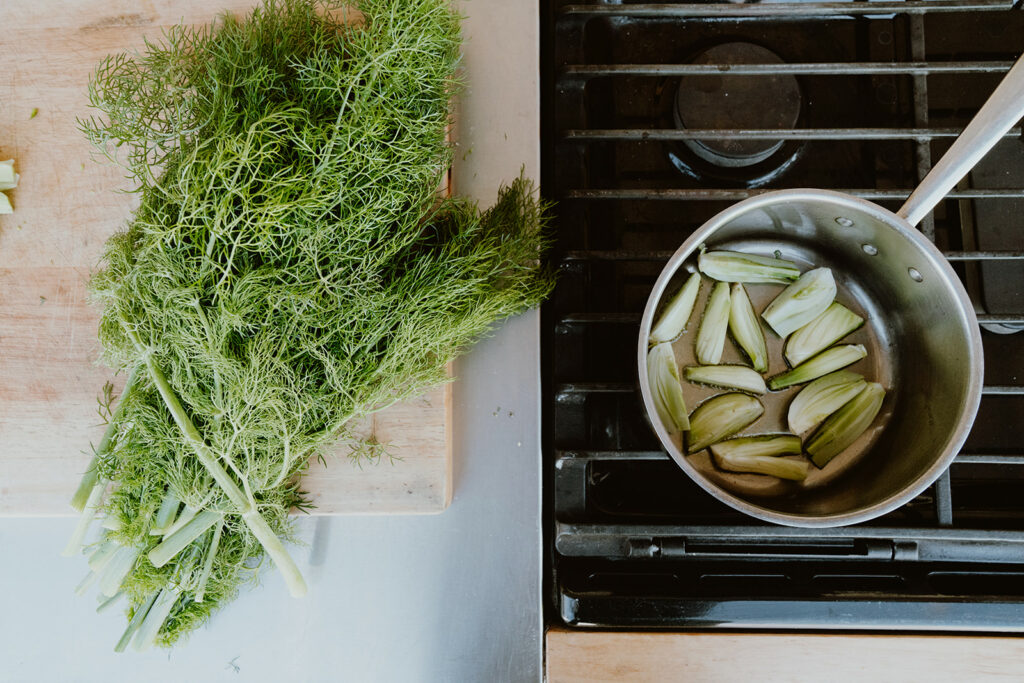
With its feathery appearance and cool, herbaceous taste, dill has long been an iconic springtime herb. A member of the parsley family, dill is native to the southern Mediterranean, though it is today most closely associated with Eastern European and Scandinavian cuisine.
SEASONAL IN SOUTHERN CALIFORNIA
PLANT: January through December
HARVEST: January through December
HISTORY
In the ancient world, dill had a variety of meanings and uses. Ancient Egyptians used dill to ward off witches, while to dill signified wealth to the Greeks and good luck to the Romans, who spread the herb throughout their empire. English immigrants brought dill to North America, where the seeds were often chewed during long religious service to dull the appetite. Strongly associated today with Eastern European and Nordic cultural cuisine, the word dill comes from an old Norse word meaning to soothe or lull.
NUTRITION
Dill is a good source of vitamins A and C, as well as several antioxidants. Traditional medicine uses dill seed to freshen breath, soothe stomach complaints, alleviate colic and indigestion in babies, and stimulate milk production in breastfeeding women.
STORAGE
Snip the ends of dill stems, place in a jar with 1 to 2 inches of water, and store at room temperature for about 2 weeks. Alternatively, lightly spray dill stems with water, wrap loosely in paper towels, and store in a sealed plastic bag for up to 1 week.
COOKING
While very popular as a pickling herb and an ingredient in classic tuna or egg salad, dill is also a natural pairing with spring and summer vegetables, such as asparagus, spinach, tomatoes, and summer squash. It’s light, herbaceous flavor complements the seafood well, especially cold-water fish like herring and salmon, as well as eggs and dairy. It blends well into cold dishes with sour flavors, such as Greek tzatziki and Eastern European borscht.
PRO TIPS
If not using a whole sprig of dill, separate leaves from stem and chop finely to use. 1 tablespoon of fresh dill substitutes for 1 teaspoon dried.
Fava Beans
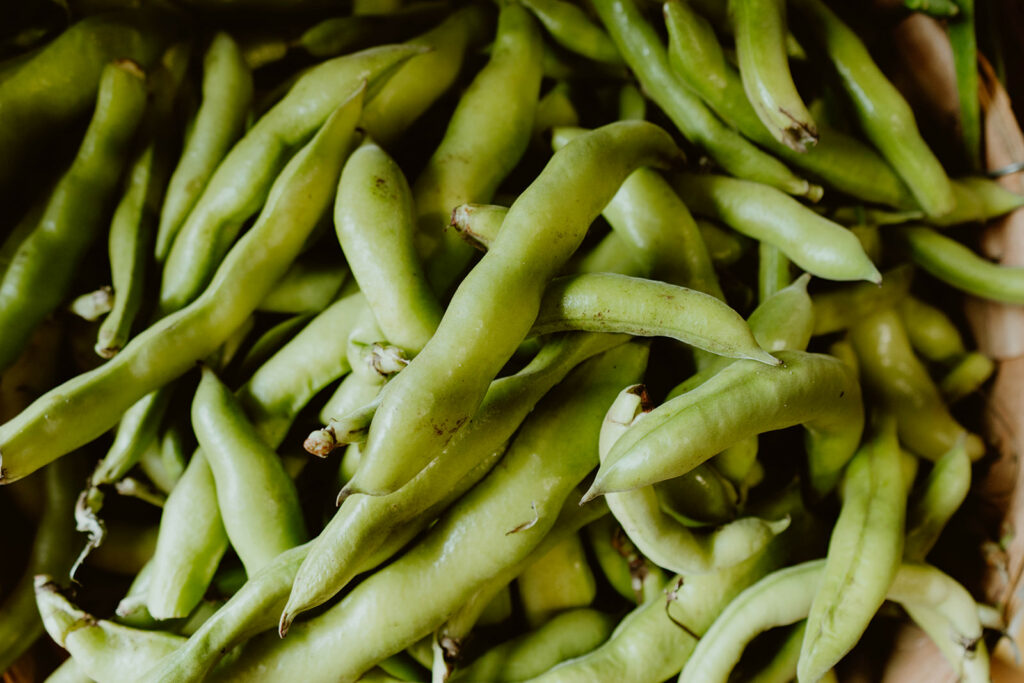
Fava beans are among the world’s oldest cultivated plants, with evidence of playing a part in human diets as far back as 6000 B.C. While many home cooks find their large size intimidating, the rich taste and smooth texture of fava beans have made them a popular seasonal ingredient for fine restaurants around the world.
SEASONAL IN SOUTHERN CALIFORNIA
PLANT: October through December
HARVEST: January through December
HISTORY
The fava bean enjoys a place of honor in many traditional cultures. The ancient Egyptians offered fava beans to the gods, and used them as a temptation exercise to purify priests. It was also believed by Mediterranean people that eating fava beans helped ward off malaria (a belief borne out by later scientific studies). Fava beans were used as the symbol for the Christ child baked into Twelfth Night Cake or King Cake, leading to their general use as a symbol of good luck. To this day, fava beans are the central dish for Sicily’s St. Joseph Day celebration, and Sicilian tradition adds that keeping a fava bean in the wallet will bring good fortune.
NUTRITION
Along with significant protein content, fava beans are an excellent source of vitamins B6 and K, as well as zinc, copper, iron, magnesium and folate.
STORAGE
Store unshelled fava beans in a plastic bag or paper sack in the refrigerator for up to 10 days.
PREPARATION
Traditional uses of fava beans include Italian risotto, Egyptian falafel, Lebanese ful medames, and Indian dal. Steamed fava beans add soft, chewy texture to salads, grain bowls, and pasta dishes. They can also be baked or fried into fritters, puréed into hummus, or grilled in the pods and eaten like edamame.
COOKING
Steam fava beans, then add to a frying pan with plenty of olive oil, salt, garlic, and chunks of spicy sausage. Fry together until the edges of beans and sausage are crisp, then remove and sprinkle with wine vinegar. Serve as a side dish or use as a filling for flatbread.
PRO TIPS
After being shelled and cooked, fava beans will still have a thin, translucent skin around them. Removing this skin before eating will make the texture more palatable and rid the bean of any residual bitterness.
Lemon Verbena
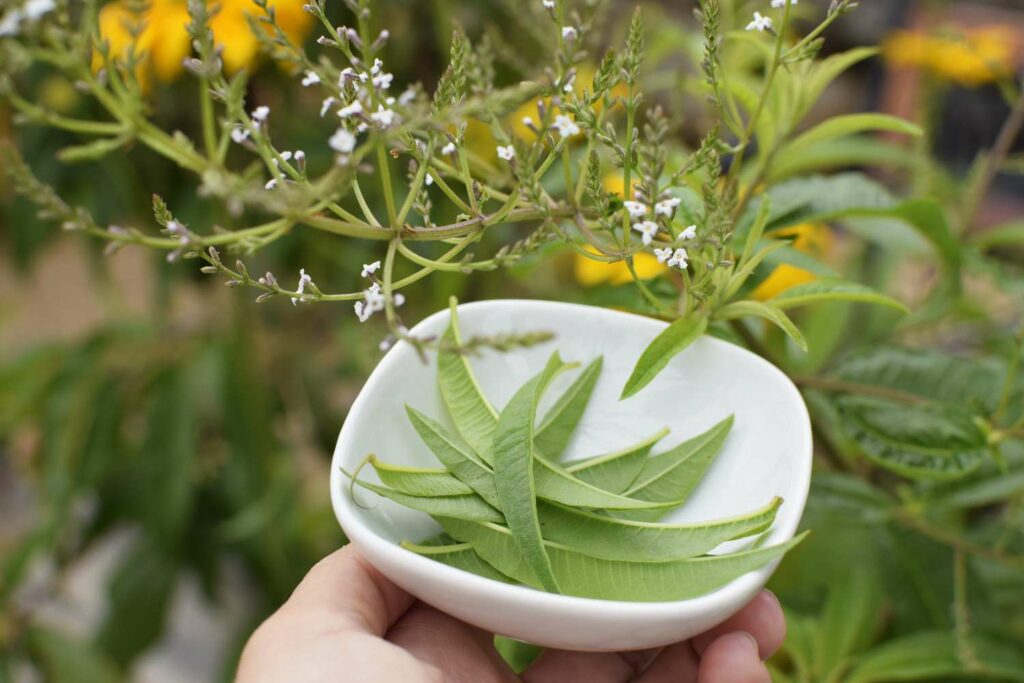
Native to the west coast of South America, lemon verbena is a perennial herb with oil-rich leaves that produce a bright, citrusy flavor. It also goes by the names cedron and yerba Luisa.
SEASONAL IN SOUTHERN CALIFORNIA
PLANT: May through September
HARVEST: January through December
HISTORY
Brought back to Europe by Spanish explorers, lemon verbena was planted in the royal botanical gardens of Madrid. After being shared with botanists in France and Britain in the late 18th century, lemon verbena became a favorite plant of the Victorian era, grown in greenhouses around London, used in fragrant bouquets, and even sewn into women’s dresses.
NUTRITION
Lemon verbena is known for a rich collection of antioxidants and bioflavonoids. One of its primary compounds, luteolin, possess anti-inflammatory and anti-tumor properties that destroy free radicals. The herb is used medicinally to ease digestive disorders, joint pain, insomnia, fever, respiratory and skin issues.
STORAGE
Stand lemon verbena sprigs in a glass of water and keep for up to 1 week. Alternatively, wrap sprigs in a damp paper towel, seal in a plastic bag or jar, and keep in the refrigerator crisper for 2 days.
PREPARATION
Lemon verbena adds a subtle citrusy flavor to fish and poultry dishes, vegetable marinades, and salad dressings. It is also a common flavoring for tea, jelly, syrup, whipped cream, and liqueur, and is a main ingredient in potpourri.
PRO TIPS
Separate desired number of leaves from stem and chop finely or use whole. 1 tablespoon of fresh lemon verbena substitutes for 1 teaspoon dried.
Lettuce
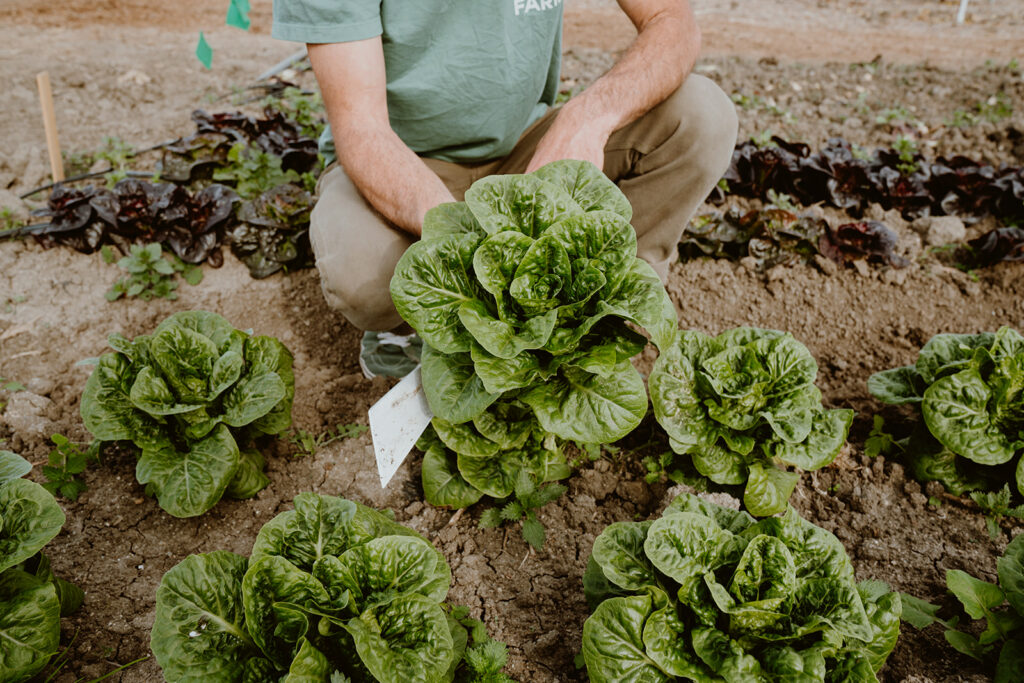
While in ancient times, lettuce was used only for the medicinal value of its seeds (the leaves were considered too bitter for human consumption), it is likely the most ubiquitous green vegetable in the Western world today. The three main categories—head lettuce, loose-leaf, and cos/romaine—all offer a light taste, crisp texture, and soft yet firm structure.
SEASONAL IN SOUTHERN CALIFORNIA
PLANT: January through December
HARVEST: January through December
HISTORY
Lettuce was first grown by ancient Egyptians as an offering to the gods. This use was passed along to the cultures of ancient Greece and Rome, who included lettuce in the origin stories of their deities. In 86 A.D., Roman emperor Domitian began serving lettuce salads at feasts to stimulate the appetite and encourage digestion. This led to Roman farmers developing many other varieties of lettuce, including the red-leaf varieties common today. More cultivars were created throughout the Middle Ages, and their ease of growth led to a rapid spread throughout the civilized world. By the 1800s, seed catalogs had begun an unscrupulous practice of renaming common lettuce varieties to trick farmers into thinking they were buying several different seeds. This, along with the subtle distinctions between varieties, makes it challenging for seed historians to trace true heirloom lettuces.
NUTRITION
While the nutritional value varies with the specific cultivar, lettuce generally is high in vitamin A, C, and K, as well as folate, calcium, magnesium, and potassium.
STORAGE
Submerge the whole lettuce head in fresh cold water, rinse thoroughly, then dry in a salad spinner until leaves are barely damp. Cover lettuce head with a paper towel to absorb moisture, and store in a half-sealed or perforated plastic bag in the refrigerator crisper for up to 5 days.
PREPARATION
Despite being best known for use in raw salads, sandwiches, and wraps, lettuce is also a handy addition to soups, stir-fry, dal, juices/smoothies, and even pesto or chutney. Well-structured leaves with firm stems can be cooked on the grill, or used as cups to hold ground meat, dip, or other fillings.
COOKING
Slice a firm lettuce variety (such as romaine or oak leaf) down the middle lengthwise, keeping the core intact. (If the lettuce head is very large, slice into quarters.) Brush lettuce sections with olive oil and crushed anchovy, if desired, and sprinkle all over with salt. Place cut side down on a hot grill for 2 to 3 minutes, pressing down to ensure a good sear. Flip and grill the opposite side for another 2 to 3 minutes. Remove from grill and top, if desired, with grated or shaved Parmesan cheese, halved cherry tomatoes, chunks of avocado, and garlic-soaked bread crumbs. Add additional olive oil, lemon juice, and salt, and pepper, and serve warm.
PRO TIPS
Slicing lettuce with a metal knife causes a reaction that encourages discoloration and wilting. To avoid this, tear lettuce leaves by hand rather than cutting them with a knife.
Oregano
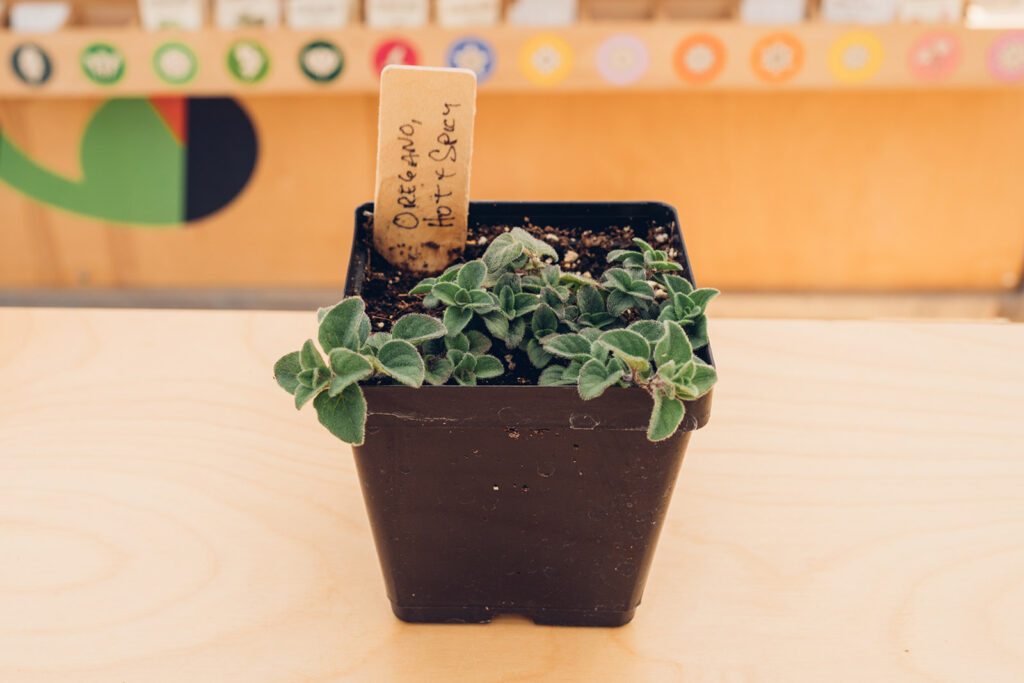
Native to the Mediterranean region and western Asia, oregano is a perennial herb related to the mint family. It is also known as wild marjoram or Spanish thyme.
SEASONAL IN SOUTHERN CALIFORNIA
PLANT: May through December
HARVEST: January through December
HISTORY
Named for Greek words meaning “joy of the mountains,” oregano has long been a flavoring for Mediterranean cuisine. It was readily adopted by the Romans, who spread it throughout the world, including Europe, North Africa, and Asia.
NUTRITION
Along with being an excellent source of vitamins E and K, manganese, iron, and calcium, fresh oregano is highly antibacterial and contains many antioxidants and phytonutrients that help infection and cell damage.
STORAGE
Stand fresh oregano sprigs upright in a container of water for up to 3 weeks. Alternatively, roll in a damp paper towel, seal in a plastic bag or jar, and keep in the refrigerator crisper for up to 1 week.
PREPARATION
Often used in Greek, Italian and Mexican cuisine, oregano has a spicy, pungent flavor. It is a key ingredient in tomato sauces, marinades, and vinaigrettes. It is excellent for adding flavor to grilled meat; you can also add a sprig or two to the inner cavity of chicken or fish before cooking. Oregano is also used as a cure for indigestion and respiratory illness.
PRO TIPS
If not using a whole sprig of oregano, separate leaves from the stem and chop finely to use. 1 tablespoon of fresh oregano substitutes for 1 teaspoon dried.
Parsley

Parsley is a member of the carrot family, native to the Mediterranean region of southern Europe and Asia. Its fresh, astringent taste, known to freshen the breath and stimulate digestion, led to its commonplace use as a plate garnish.
SEASONAL IN SOUTHERN CALIFORNIA
PLANT: January through December
HARVEST: January through December
HISTORY
The name parsley comes from Greek words meaning rock celery because the plant thrives on rocks and walls. The ancient Greeks feared parsley as a symbol of death, thanks to its use as an aromatic to cover the smell of disease and decay. The Romans are credited with the first culinary use of parsley to aid in digestion; parsley was also used at orgies to mask the smell of alcohol on the breath. Some credit Holy Roman Emperor Charles the Great for spreading the use of parsley around the Western world by growing it all over his palace grounds, while others give credit to Catherine de Medici for bringing it from Italy and incorporating it into French cooking.
NUTRITION
Parsley is rich in vitamins A and C, as well as compounds that clear toxins, reduce inflammation, and inhibit histamines and free radicals from the body. Since ancient times, parsley has been used as an antidote to poison, as well as a general tonic for digestion, urinary tract health, and dry hair and skin.
STORAGE
Snip off ends of parsley stems, place in a jar with 1 to 2 inches of water, and store at room temperature for up to 3 weeks. Alternatively, wrap parsley sprigs in a damp paper towel, seal in a plastic bag or jar, and keep in the refrigerator crisper for up to 2 weeks.
PREPARATION
Parsley is a key herb in French cooking and is included with tarragon, chives, and chervil under the term fines herbs. Parsley adding fresh flavor to spring and summer vegetables such as peas, green beans, tomatoes, peppers, eggplant, and summer squash, as well as seafood, poultry, and egg dishes. It is the flagship ingredient in French persillade and Italian gremolata, both sauces that combine parsley with garlic and other ingredients to flavor roasted or broiled meat and poultry. It is also a popular ingredient in green juices, thanks to its cleansing effect and use as a digestive stimulant.
PRO TIPS
If not using a whole sprig of parsley, separate leaves from the stem and chop finely to use. 1 tablespoon of fresh parsley substitutes for 1 teaspoon dried.
Parsnip
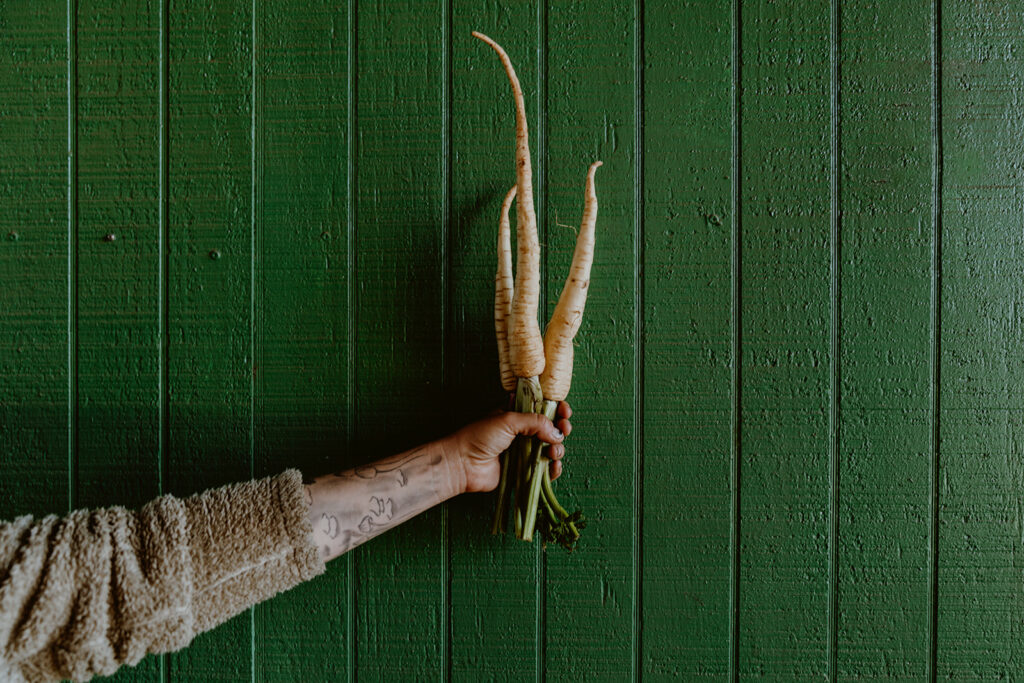
Cultivated since the birth of agriculture, parsnips have been a primary food from ancient Rome to the early days of colonial America. The large, tapering white root is commonly mistaken for carrots or even daikon radish, but its distinctive sweetness made it useful not only as a root vegetable but also as a sweetener before sugar was widely available.
SEASONAL IN SOUTHERN CALIFORNIA
PLANT: November through February
HARVEST: November through March
HISTORY
Before the potato was introduced from the Americas, parsnips were the root vegetable of choice for European kitchens. The Roman emperor Tiberius liked parsnips so much that he accepted them as tribute from his subjects. Brought to North America by French and English colonists, parsnips were quickly adopted by the surrounding indigenous nations.
NUTRITION
Parsnips are a popular substitute for potatoes, thanks to being lower in simple carbohydrates. Their high fiber content makes them excellent for digestive health as well as regulating blood sugar. Parsnips are also high in Vitamin C, folate, and manganese. For all these reasons, parsnips have historically been fed to the elderly, the weak, and those convalescing from sickness.
STORAGE
Be careful when handling greens, as they can cause a reaction to sensitive skin. Parsnips wrapped in a towel or perforated bag and stored in the refrigerator will keep for about 3-4 weeks. Do not wash or peel until just before cooking.
PREPARATION
While the dense flesh of parsnip can take quite a long time to cook, they provide a rich, caramelly flavor when roasted, baked, or fried. In many English-speaking cultures, parsnips are a mainstay of winter holiday feasts. Popular modern methods of cooking parsnips include adding them to mashed potatoes or frying thin slices into chips.
COOKING
Peel and quarter parsnips, then drop into a pot of barely simmering coconut milk spiced with fresh ginger, nutmeg, cardamom, and/or curry powder. Poach until parsnips are almost tender, then remove and add to a pan and sauté with butter and salt. When parsnips are caramelized, add a splash of coconut milk from the poaching liquid, and reduce it until the milk is thickened into a glaze.
PRO TIPS
While most people enjoy the faint aroma of raw parsnips, some people may develop an allergic-like reaction to it. There are no known toxins in domesticated parsnips, and cooking eliminates any negative effects from the smell. If you find the smell of parsnips unpleasant, keep them tightly wrapped until ready to cook.
Peas
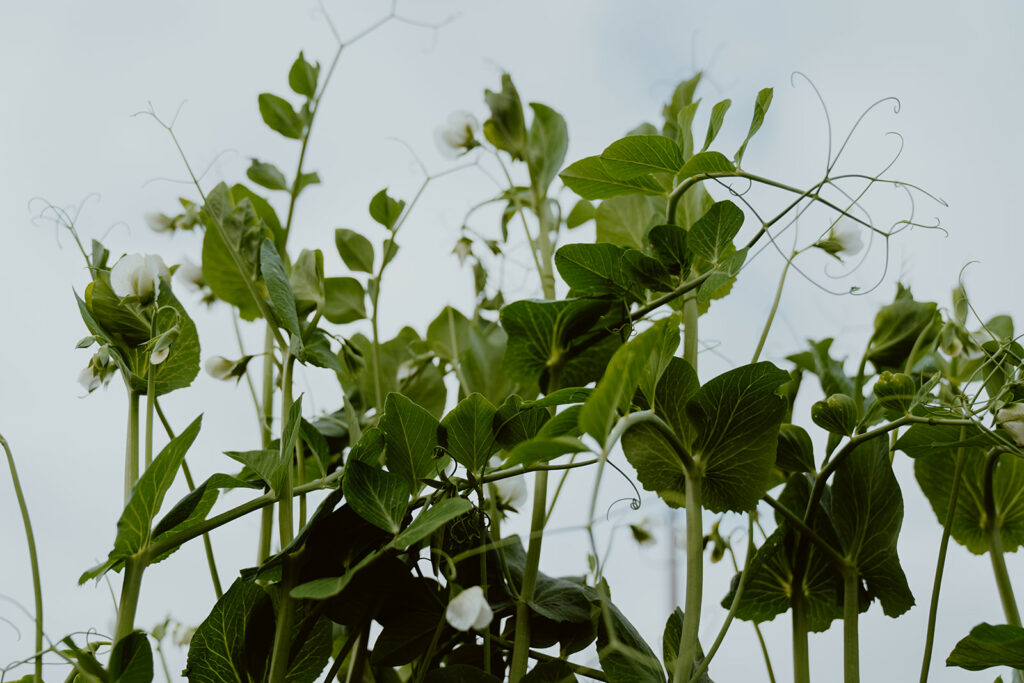
One of the world’s oldest cultivated crops, the pea is a legume that has fostered the development of agriculture and science throughout history. Along with providing reliable nourishment throughout times of famine, peas were the basis of Mendel’s 1856 experiments in genetics, as well as the birth of frozen food preservation in the 1920s.
SEASONAL IN SOUTHERN CALIFORNIA
PLANT: January through December
HARVEST: October through June
HISTORY
Native to the Mediterranean region, there is evidence of pea cultivation dating as far back as the late Neolithic Period. By the Middle Ages, peas were a staple survival crop in Europe, the Middle East, and North Africa. Initially, only the dried seeds were eaten by peasants, but by the early days of modern Europe, fresh green peas were eaten as a delicacy. This led to the development of new cultivars, known as English peas, meant to be eaten fresh. By the 19th century, the modern split pea—green peas with their skins removed to encourage a natural divide in the legume—had become a common kitchen ingredient around the world.
NUTRITION
Peas are an excellent source of vitamin A, B1, and C, as well as folate, iron, and phosphorus.
STORAGE
Store unwashed, unshelled peas in a perforated bag or unsealed container in the refrigerator crisper for up to 5 days. Peas can also be blanched in boiling water for 1 to 2 minutes and then frozen for up to 6 months.
PREPARATION
Fresh peas add a bright pop of sweet flavor and juicy texture to any dish. Add steamed or roasted peas to soup, stir-fry, curry, rice, or pasta, or use as a bed for seafood, chicken, or meat. Peas pair well with creamy dishes such as polenta, chowder, or thick stews, and offer a sweet, fresh counterpoint to rich and salty flavors such as cured meats or cheese. They can also be puréed with garlic and herbs as a side dish or a dip.
COOKING
Toss fresh peas with crushed garlic, olive oil, and salt, then add to a hot frying pan and roast over high heat, turning constantly, until peas are lightly blistered all over. Remove from heat and sprinkle with finely chopped herbs, a splash of lemon juice, and crumbled fontina cheese, if desired.
PRO TIPS
Shelled pea pods can be added to vegetable stock or braising liquid for a boost of flavor and nutrition.
Peas

One of the world’s oldest cultivated crops, the pea is a legume that has fostered the development of agriculture and science throughout history. Along with providing reliable nourishment throughout times of famine, peas were the basis of Mendel’s 1856 experiments in genetics, as well as the birth of frozen food preservation in the 1920s.
SEASONAL IN SOUTHERN CALIFORNIA
PLANT: January through December
HARVEST: October through June
HISTORY
Native to the Mediterranean region, there is evidence of pea cultivation dating as far back as the late Neolithic Period. By the Middle Ages, peas were a staple survival crop in Europe, the Middle East, and North Africa. Initially, only the dried seeds were eaten by peasants, but by the early days of modern Europe, fresh green peas were eaten as a delicacy. This led to the development of new cultivars, known as English peas, meant to be eaten fresh. By the 19th century, the modern split pea—green peas with their skins removed to encourage a natural divide in the legume—had become a common kitchen ingredient around the world.
NUTRITION
Peas are an excellent source of vitamin A, B1, and C, as well as folate, iron, and phosphorus.
STORAGE
Store unwashed, unshelled peas in a perforated bag or unsealed container in the refrigerator crisper for up to 5 days. Peas can also be blanched in boiling water for 1 to 2 minutes and then frozen for up to 6 months.
PREPARATION
Fresh peas add a bright pop of sweet flavor and juicy texture to any dish. Add steamed or roasted peas to soup, stir-fry, curry, rice, or pasta, or use as a bed for seafood, chicken, or meat. Peas pair well with creamy dishes such as polenta, chowder, or thick stews, and offer a sweet, fresh counterpoint to rich and salty flavors such as cured meats or cheese. They can also be puréed with garlic and herbs as a side dish or a dip.
COOKING
Toss fresh peas with crushed garlic, olive oil, and salt, then add to a hot frying pan and roast over high heat, turning constantly, until peas are lightly blistered all over. Remove from heat and sprinkle with finely chopped herbs, a splash of lemon juice, and crumbled fontina cheese, if desired.
PRO TIPS
Shelled pea pods can be added to vegetable stock or braising liquid for a boost of flavor and nutrition.
Radicchio
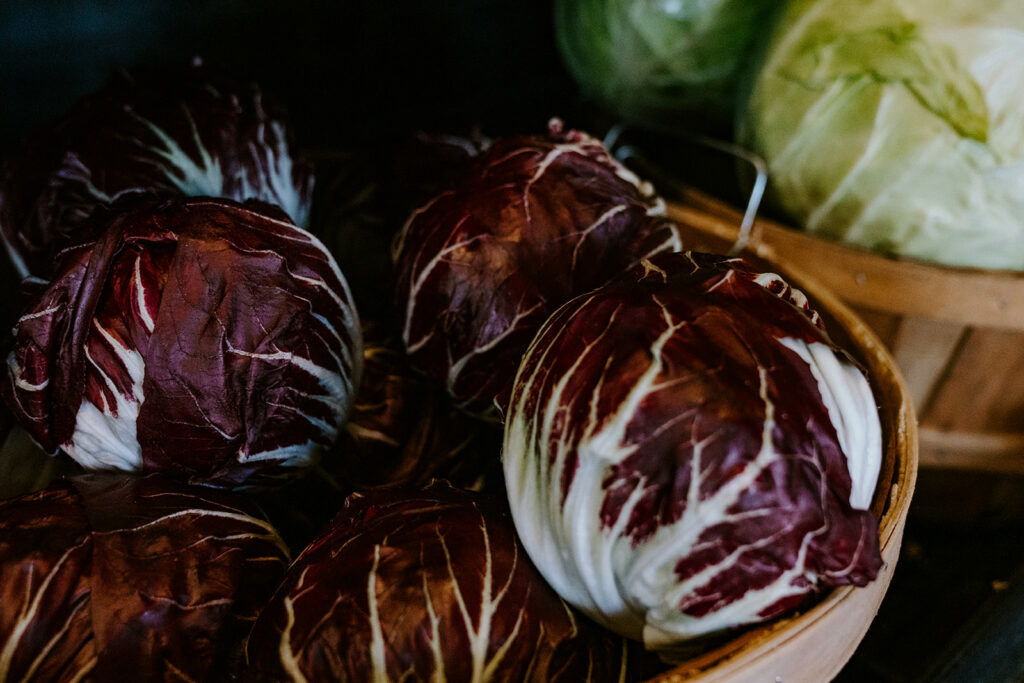
Sometimes known as Italian chicory, radicchio is a common addition to salad mixes for its beautiful coloring and piquant bitter flavor. Along with its culinary uses, radicchio has long been used medicinally as a blood purifier, a liver tonic, and even an ingredient in cosmetics to soothe irritated skin.
SEASONAL IN SOUTHERN CALIFORNIA
PLANT: January through December
HARVEST: November through May
HISTORY
Descended from wild chicory plants, radicchio was first cultivated in the fifteenth century in the northern regions of Italy. In 1860, a Belgian agronomist developed a growing technique known as “whitening” or “preforcing” to encourage the plant’s intensity of color. Despite being a commonplace ingredient in European cuisine for centuries, radicchio was not commercially grown in the United States until the 1980s.
NUTRITION
Radicchio is rich in vitamins A, C, and K, as well as iron, selenium, phosphorus, potassium, and calcium.
STORAGE
Wrap the whole, unwashed head of radicchio in a dampened paper towel and store in a half-sealed bag in a refrigerator crisper for up to 4 days. Wilted leaves can sometimes be revived by soaking in cold water.
PREPARATION
Radicchio is traditionally eaten grilled with olive oil, or mixed into heavy dishes such as risotto. It can also be served with pasta, used as a poultry stuffing, or be included in the flavorful condiment tapenade. The cup-shaped leaves can also be used to serve dips or chicken or tuna salad.
COOKING
Cut the whole radicchio into wedges, toss with olive oil, and top with shaved semi-hard cheese such as Gruyere or Reggiano. Broil at high heat until the red leaves turn reddish-brown. Serve warm with a citrus vinaigrette.
PRO TIPS
If you find your radicchio too bitter, try soaking leaves in cold water for two hours before preparing.
Radish
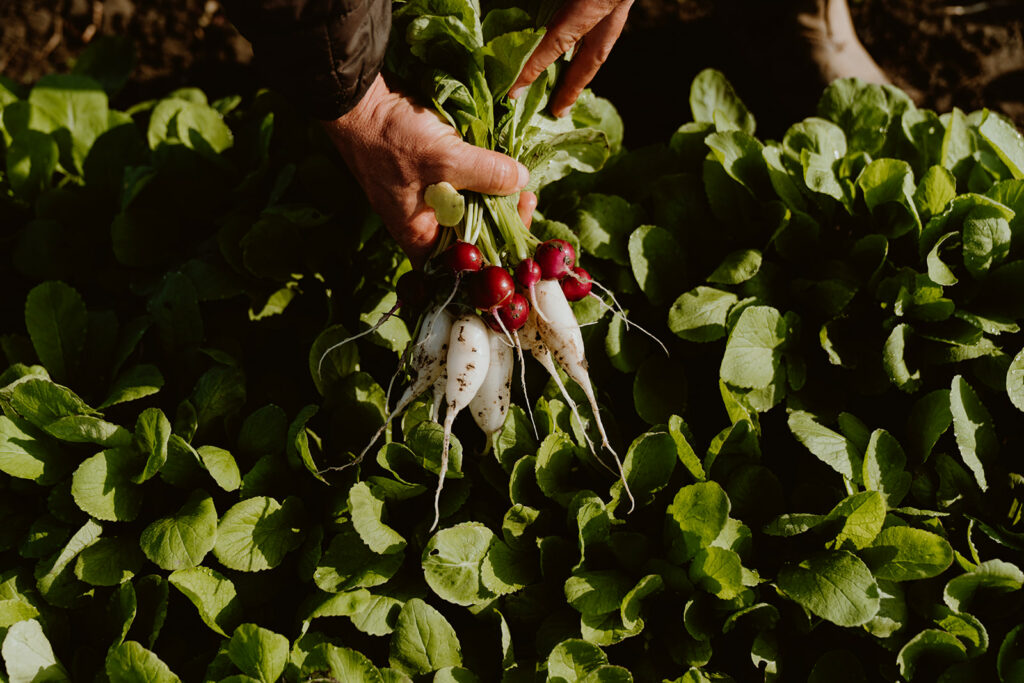
This spicy-sweet brassica boasts a surprising range, with a wide spectrum of shapes, colors, flavors, and growing seasons. It plays a role in traditional food cultures around the world, from Japan to Mexico to France.
SEASONAL IN SOUTHERN CALIFORNIA
PLANT: January through December
HARVEST: January through December
HISTORY
The radish is believed to have been domesticated in Central Asia around the 3rd century BC and spread quickly to Europe and later the Americas. It has played a role in food cultures throughout time, from the Egyptian laborers who built the pyramids being paid in radishes, to the people of Oaxaca, Mexico who still celebrate a holiday known as Night of the Radishes.
NUTRITION
Radishes are a rich source of vitamins C and B6, potassium and calcium, as well as trace minerals such as magnesium and copper.
STORAGE
Snip off leaves about ¼ inch from the top of the radish, clean off any soil, wrap in a cloth or paper towel, and store in an unsealed bag or container in the refrigerator crisper for up to 2 weeks.
PREPARATION
The raw radish can be julienned or shaved as a topping for tacos, added to slaws, or fermented with rice vinegar and soy for an Asian pickle. Radishes can be roasted, braised, or even halved and added to the grill—the smoky char adds a wonderful dimension to their spicy flavor. Radish leaves add a kick to any salad or sauteed greens.
COOKING
Thinly slice or shave radishes, and toss with a mixture of shredded cabbage and cilantro. Add lime juice, olive oil, and salt, and allow to marinate. Serve alongside enchiladas or barbacoa, or add avocado chunks and toasted pepitas for a delicious salad.
PRO TIPS
Most of the radish’s spicy flavor is concentrated in the skin. Leave on to enjoy the tangy kick, or for a mellower flavor, simply peel before cooking or eating. Larger radishes can sometimes have a bitter flavor—remove by salting and letting them sit for a while before serving.
Rosemary
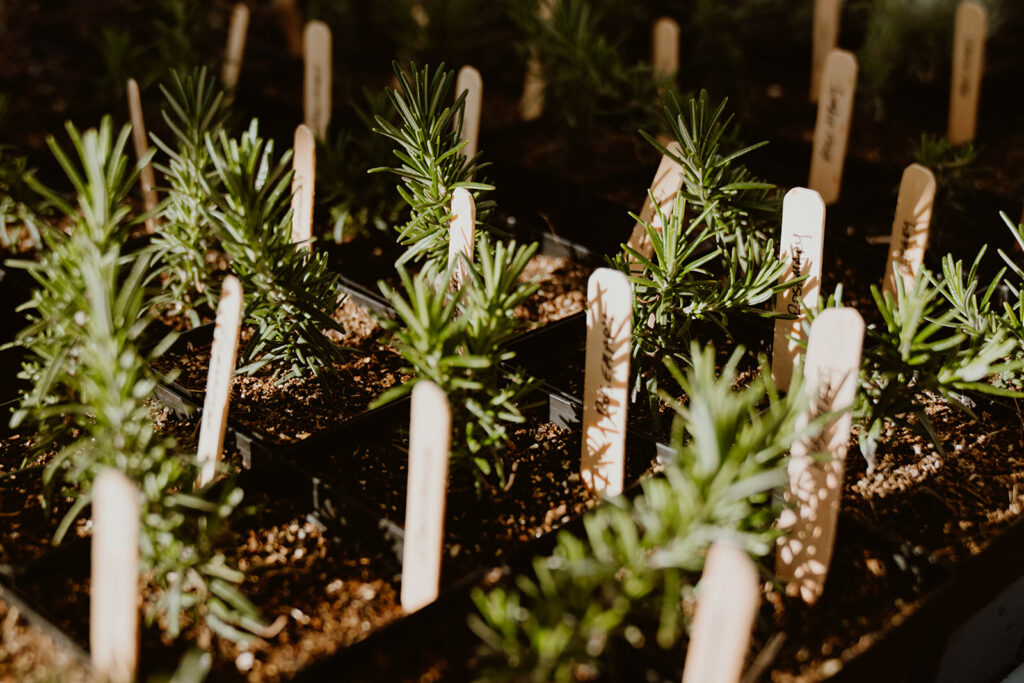
Rosemary is a small evergreen plant of the mint family, native to the dry, rocky areas of the Mediterranean coast.
SEASONAL IN SOUTHERN CALIFORNIA
PLANT: January through May
HARVEST: November through May
HISTORY
Rosemary’s name derives from Latin words meaning “dew of the sea.” Used in cooking since the time of the early Greeks and Romans, rosemary also symbolized love and remembrance. Rosemary was gifted to the queen of England in the 14th century by a Dutch countess, and was brought to North America by early European settlers.
NUTRITION
Along with being a rich source of antioxidant, antibacterial and anti-inflammatory compounds, rosemary is a cognitive stimulant, aiding with focus and memory. Rosemary is often used for digestion problems such as heartburn, liver and gallbladder complaints, and loss of appetite.
STORAGE
Wrap rosemary sprigs in a damp paper towel, seal in a plastic bag or jar, and keep in the refrigerator crisper for up to 3 weeks.
PREPARATION
Rosemary is well suited to seasoning simple, hearty soups and stews. Its flavor compliments pork, game, beef and lamb. It also goes well with the earthy flavors of grains, mushrooms, and root vegetables.
PRO TIPS
If not using a whole sprig of rosemary, separate leaves from stem and chop finely to use. 1 tablespoon of fresh rosemary substitutes for 1 teaspoon dried.
Sage
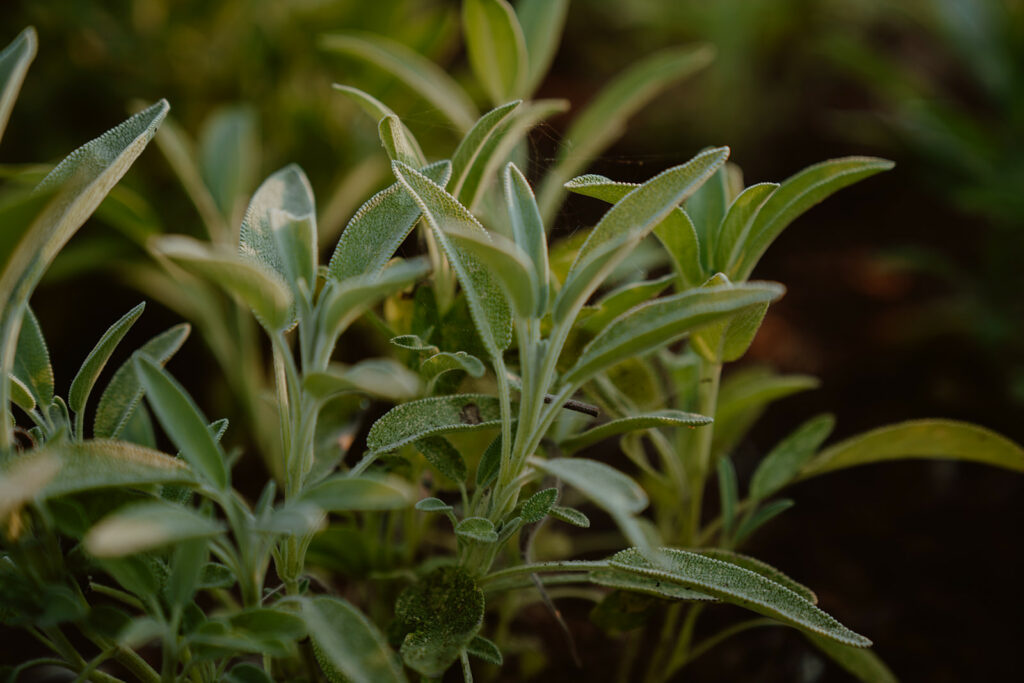
Native to the Mediterranean coast, common sage is named for the Latin word meaning “to be saved,” thanks to its reputation as a medicinal cure-all.
SEASONAL IN SOUTHERN CALIFORNIA
PLANT: January through May
HARVEST: January through December
HISTORY
Ancient Egyptians used sage to stimulate fertility and to treat infectious diseases; it was also the main ingredient used in embalming. The Greeks and Romans used sage medicinally to enhance memory, while in the kitchen it was used as a meat preservative. The ancient Chinese eagerly adopted the use of sage and traded four pounds of tea for every one pound of sage. Today, there are over 700 species of sage spread throughout the world.
NUTRITION
Sage is high in vitamins A, C, E, and K and is a good source of folate, calcium, iron, magnesium, and manganese. It has shown promise in treating Alzheimer’s disease, cardiovascular disease, depression, and menopause symptoms. Its antiseptic properties can also help heal a sore throat, canker sores, gum disease, and fungal infections.
STORAGE
Wrap sage sprigs in a damp paper towel, seal in a plastic bag or jar and keep in the refrigerator crisper for up to 5 days. Alternatively, cover leaves with olive oil and store them in the refrigerator for about 3 weeks.
PREPARATION
With a dusky, dry flavor that complements meat and poultry, sage is a regular addition to traditional stuffing, as well as classic soup, stew, and sauce recipes. Sage leaves fried in butter are a delicious garnish for seafood and pasta.
PRO TIPS
If not using a whole sprig of sage, separate leaves from the stem and chop finely to use. 1 tablespoon of fresh sage substitutes for 1 teaspoon dried.
Spinach
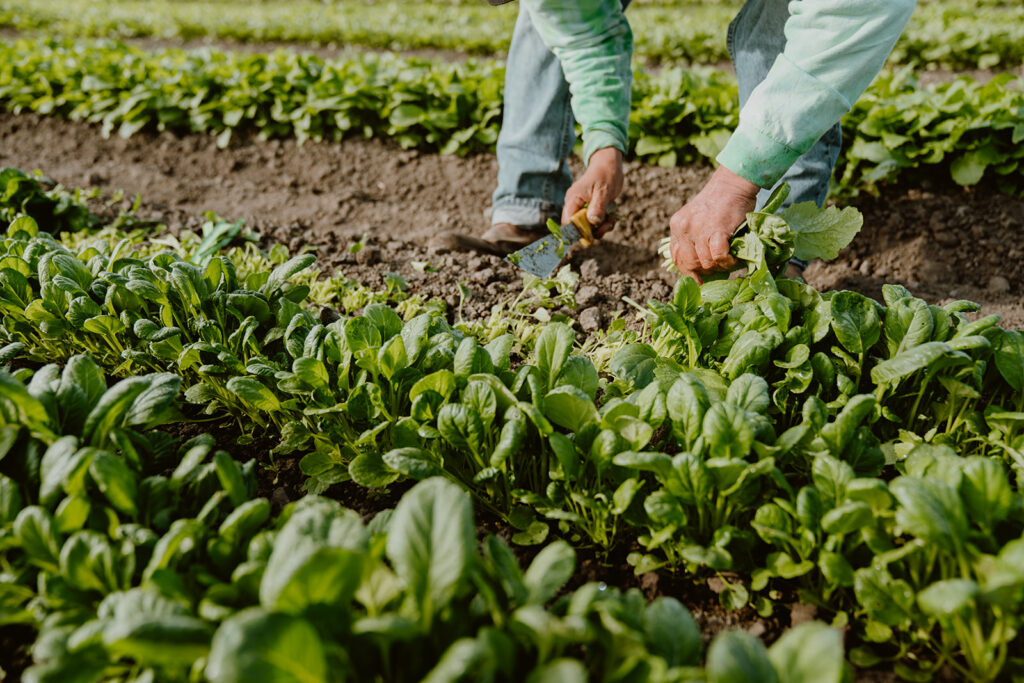
Beloved for its juicy sweetness and high nutrition content, spinach is the rare green that doesn’t feature any bitter taste.
SEASONAL IN SOUTHERN CALIFORNIA
PLANT: October through June
HARVEST: October through June
HISTORY
Spinach is believed to have originated about 2000 years ago in ancient Persia. It was introduced to China in the 7th century as a gift from the king of Nepal, and spread from there to India and the Middle East. Two hundred years later, Middle Eastern explorers introduced spinach to Europe. Its popularity skyrocketed during the Renaissance, thanks to Catherine de Medici, queen of Florence’s ruling family. Thanks to her love for spinach, dishes that include the vegetable are frequently said to be prepared “à la Florentine.”
NUTRITION
Spinach is legendary for being extremely nutrient-rich. Its dense mineral profile includes iron, potassium, magnesium, and calcium, and it has high concentration of vitamins B6, B9, C, E and K.
STORAGE
Thoroughly rinse spinach leaves and spread to dry on a towel (or spin in a salad spinner). When very dry, pack loosely in a plastic bag with a paper towel inside to absorb moisture. Spinach will stay fresh up to a week, but make sure to check every few days to remove any wilting or rotten leaves.
PREPARATION
Spinach’s natural sweetness makes it an easy addition to just about any recipe. Toss a handful of torn spinach leaves into soups, stews, pasta sauces, even smoothies or juices for an extra kick of nutrition. Cooked spinach can be added to egg dishes, grain bowls, bean dishes, or dips, or stuffed into meat or fish.
COOKING
Fry chopped garlic cloves in olive oil, then stir in a heaping spoonful of smoked Spanish paprika. Add several handfuls of fresh spinach leaves and a small amount of water, and cook until water is absorbed and spinach is wilted. Add a handful or two of cooked chickpeas, season with salt and additional paprika, and stir until heated through. Serve with more olive oil and crusty bread.
PRO TIPS
No need to remove spinach stems—they are tender and soften easily when cooking. They are also good for your health, with an extra dose of vitamins and minerals.
Sunchokes
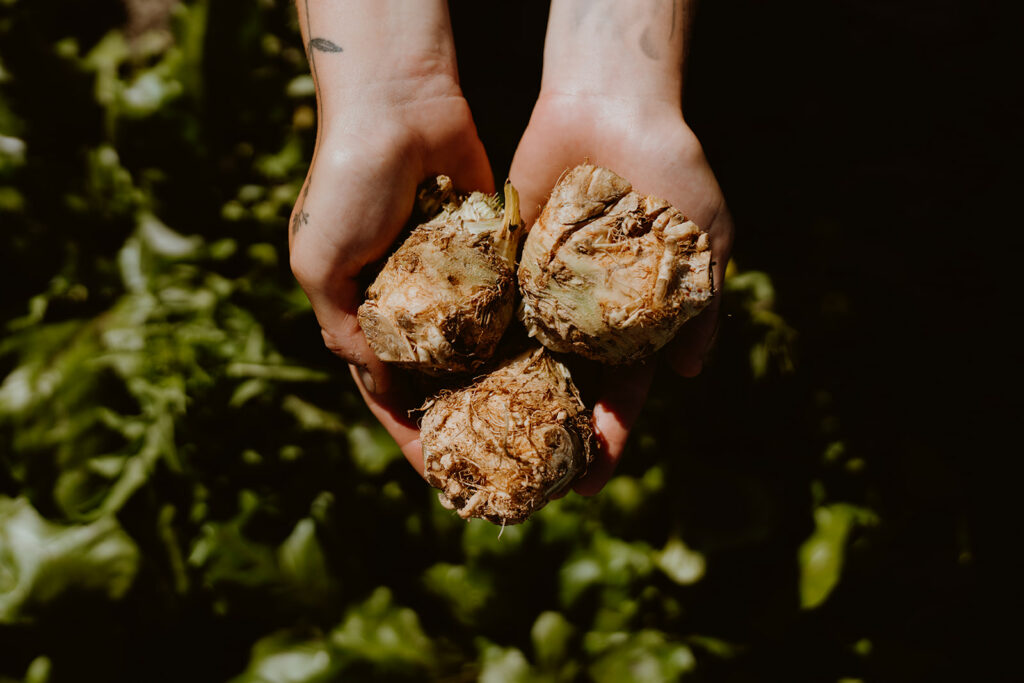
The sunchoke, sometimes known as the Jerusalem artichoke or Canadian truffle, is the edible root of a perennial sunflower. Their small, knobby appearance and papery skin is similar in appearance to fresh ginger. Their name, coined in the 1960s, is a portmanteau of “sunflower” and “artichoke,” with which they share certain flavor characteristics.
SEASONAL IN SOUTHERN CALIFORNIA
PLANT: July through December
HARVEST: July through December
HISTORY
Sunchokes were common in Native American foodways—they were eaten mashed and used as a thickener for soups and stews. It’s believed that this critical indigenous food source was key to the survival of early French Canadian settlers. European colonists sent sunchoke tubers back to the Old World, where they became quite popular in England, France, and the Netherlands.
NUTRITION
A rich source of iron, calcium, magnesium, and potassium, sunchokes also contain the carbohydrate inulin, which can help to stabilize blood sugar and function as a prebiotic.
STORAGE
Sunchokes can be stored for 1-2 weeks in the refrigerator if wrapped in paper towels and sealed in an airtight bag or container. They can also be stored in a cool, dry, and well-ventilated area away from direct light. Be sure to handle sunchokes gently, as they bruise easily.
PREPARATION
The nutty, sweet flavor of sunchokes is paired with a yielding, creamy texture like that of a fingerling potato. Their low starch content makes them a popular substitute for potatoes when baked, fried, or mashed, but they can also be sliced and eaten raw, as well as pickled or made into chutney.
COOKING
Peel and cut sunchokes into bite-size chunks, and roast at 425 degrees for about 20 minutes, turning halfway through. While roasting, combine equal parts honey and soy sauce in a pan and warm over medium-low heat until thickened slightly. When sunchokes are tender, remove and toss with honey-soy glaze. Serve warm, topped with toasted sesame seeds.
PRO TIPS
The high inulin content of sunchokes sometimes leads to an unwanted gassy effect. To prevent this, boil sunchokes in lemon juice for about 15 minutes before cooking. This will also help sunchokes retain their pale color when cut and cooked.
Tarragon
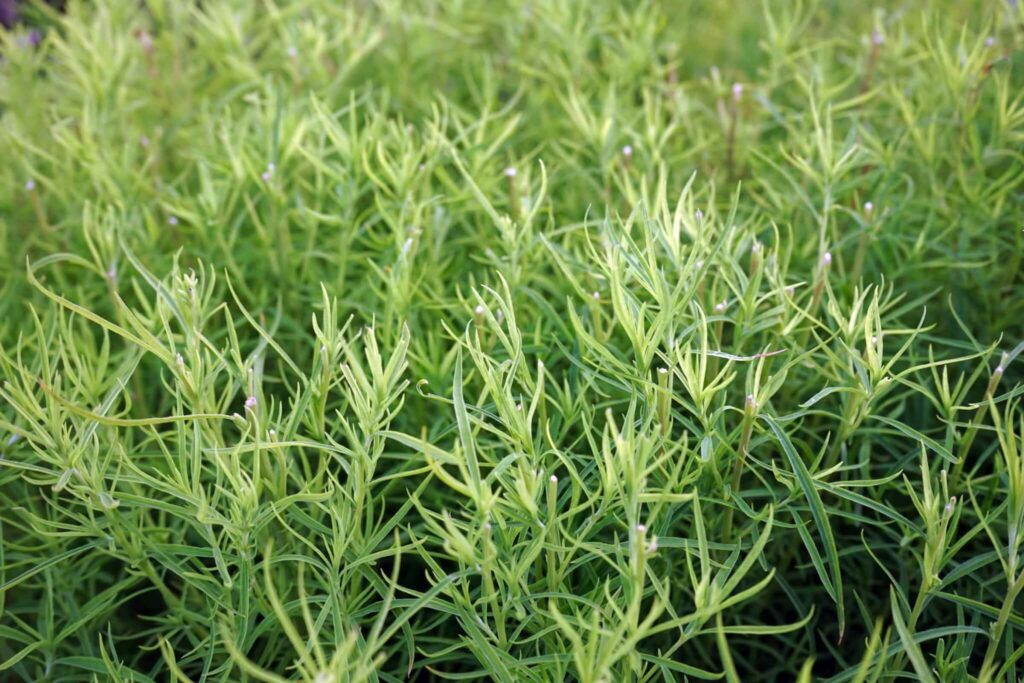
Tarragon is a perennial herb native to Siberia, with a strong anise-like flavor (their oils are chemically identical). Its name is derived from a Latin word meaning “little dragon,” thanks to its twisting roots, and it was traditionally believed to cure dragon bites as well as insomnia and bad breath.
SEASONAL IN SOUTHERN CALIFORNIA
PLANT: January through May
HARVEST: January through December
HISTORY
Tarragon is a fairly “young” herb, having only been cultivated for around 600 years. It is believed that invading Mongols brought tarragon to Italy sometime in the 10th century. In the 14th century, St. Catherine carried tarragon with her on a pilgrimage to France, where it is principally used today. celebrate a holiday known as Night of the Radishes.
NUTRITION
Tarragon is a good source of vitamins A, B6, and C, as well as folate, calcium, iron, magnesium, potassium, and manganese. Tarragon has been traditionally used to treat poor digestion, intestinal problems, rheumatism, gout, arthritis, and toothache.
STORAGE
Wrap tarragon sprigs in a damp paper towel, seal in a plastic bag or jar and keep in the refrigerator crisper for up to 3 weeks.
PREPARATION
Tarragon is a key herb in French cooking and is included with chervil, chives, and parsley under the term fines herbs.It is the main flavoring in béarnaise sauce, features in a number of Eastern European recipes, and is a principal herb in Persian-style pickles. Tarragon goes well with poultry, fish, and egg dishes, and is complemented by acidic flavors in citrus and vinegar, making it a popular addition to salad dressings and marinades.
PRO TIPS
If not using a whole sprig of tarragon, separate leaves from the stem and chop finely to use. 1 tablespoon of fresh tarragon substitutes for 1 teaspoon dried.
Thyme
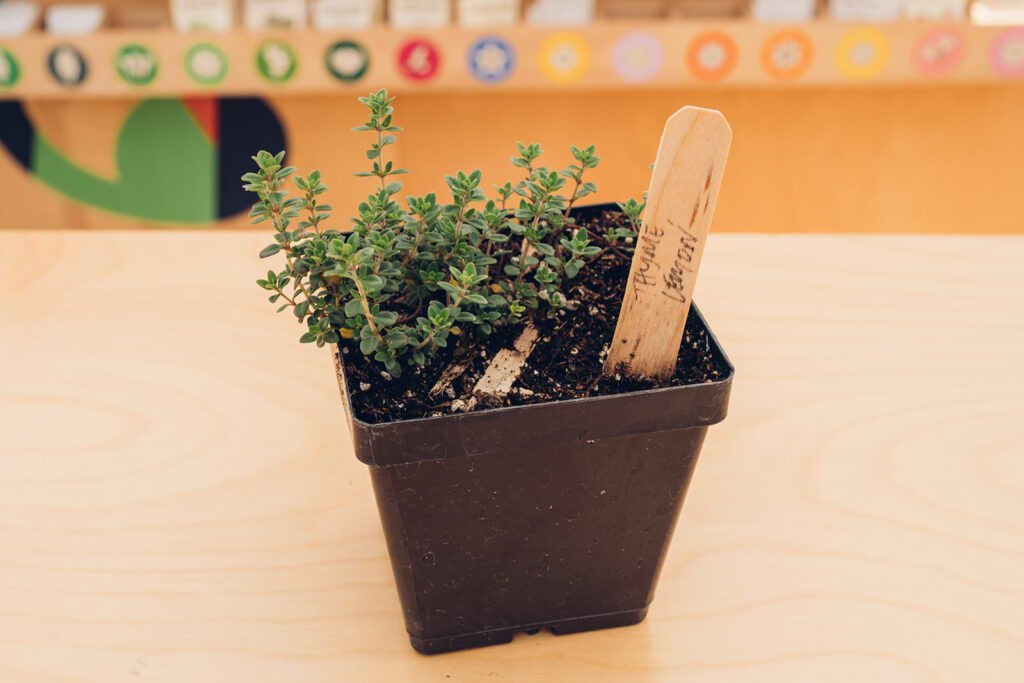
A member of the mint family with small curling leaves, thyme is native to the southern Mediterranean region. Its antimicrobial properties have led to its long use as a food preservative, as well as a healing and purifying medicinal herb.
SEASONAL IN SOUTHERN CALIFORNIA
PLANT: January through May
HARVEST: January through December
HISTORY
Thyme was used as an embalming ingredient by the ancient Egyptians, and bundles of thyme were traditionally burned by ancient Greeks and Romans to purify both homes and temples. The Romans also ate thyme sprigs before and after a meal, believing it to be an antidote to poison. This tradition continued with medicinal potions made from thyme used to combat the Black Death in the 1340s. Even in the 19th century, nurses soaked bandages in thyme-infused water. Throughout history, thyme was also used in baking, cooking and food preservation to help protect against spoilage and foodborne disease.
NUTRITION
Along with nutrients such as vitamins A and C, potassium, and magnesium, thyme is known for containing a powerful antiseptic known as thymol, a common ingredient in mouthwash, hand sanitizer and acne medication.
STORAGE
Stand thyme sprigs in a jar with 1 to 2 inches of water, and keep for up to 3 weeks. Alternatively, wrap thyme sprigs in a damp paper towel, seal in a plastic bag or jar, and keep in the refrigerator crisper for up to 1 week.
PREPARATION
With its deep, pungent flavor, thyme is part of the traditional French bouquet garni used to flavor stock and soups, as well as the Middle Eastern spice mix za’atar. Another popular use of thyme is infusing it into oil or butter and using to baste meat, poultry or fish while roasting or grilling. It offers warm, earthy flavor to grains and legumes, as well as marinades and vinaigrettes, and is a tasty addition when sprinkled onto garlic bread. It also pairs well with sweet flavors, and can be infused into jellies or syrups for use in dessert or cocktails.
PRO TIPS
If not using a whole sprig of thyme, separate leaves from stem and chop finely to use. 1 tablespoon of fresh thyme substitutes for 1 teaspoon dried.
Winter Squash
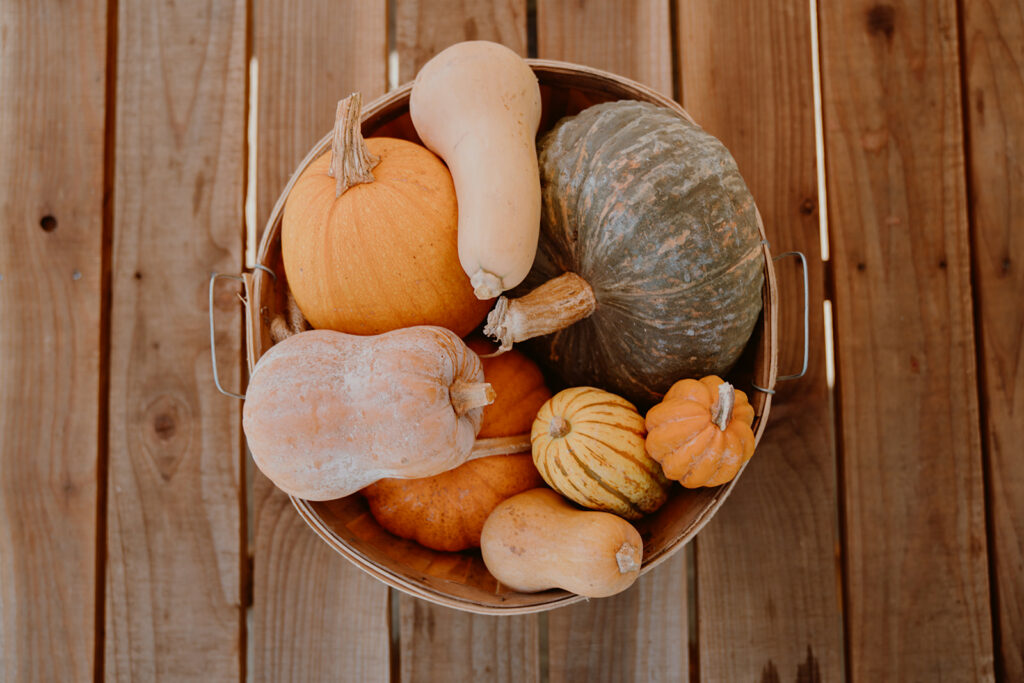
This hard-shelled vining fruit is a mainstay of indigenous American foodways. Beloved today for its sweet taste, soft texture and filling nutrition, winter squash was traditionally consumed in its entirety, with flesh and seeds roasted for food, and shells dried out for use as containers and water vessels.
SEASONAL IN SOUTHERN CALIFORNIA
PLANT: July through May
HARVEST: October through June
HISTORY
Native to Mexico and Central America, winter squash were used to pioneer the method of “companion planting,” in which crops were planted in pairs to contribute to each other’s growth. In the American southwest, winter squash, corn and beans were known as the Three Sisters, and planted in a system known as the milpa. Carried across the Atlantic by European invaders, winter squash was embraced by people around the Mediterranean Basin, and eventually carried to Asia by Portuguese traders in the 16th century.
NUTRITION
supplied beta carotene, Omega 3’s and Potassium
STORAGE
Unpeeled, uncut winter squash can be kept for up to 3 months in a cool, dark, well-ventilated location. Cut and peeled squash can be kept in a sealed plastic bags in the refrigerator crisper for up to 5 days.
PREPARATION
Winter squash is one of the easiest vegetables to prepare: simply slice in half, remove seeds, and roast at high heat until flesh is soft enough to scrape out of the skin. Squash can also be peeled and cubed before being cooked. Starchy varieties like kabocha and kuri are best for frying and baking, while dense varieties such as pumpkin and acorn squash are better for baking or steaming, and the softer butternut and delicata are ideal for purées, soups, stews and curries.
COOKING
Cut winter squash down the middle, remove seeds, and roast at 450 for about 60 minutes, or until squash can be easily pierced with a fork. Let cool slightly and scoop flesh out of skin. Add cooked squash to a high-speed blender with sautéed onions and garlic, a whole apple (seeds removed), and enough vegetable broth to barely cover. Add your favorite spices such as curry and garam masala, cumin and chile, or cinnamon, nutmeg and pepper. Add a dash of cream or coconut milk, if desired. Process in a blender until mixture is thick and smooth. Add salt and pepper to taste, and serve topped with roasted squash seeds.
PRO TIPS
Winter squash seeds can be easily removed using a melon baller or ice cream scoop in place of a spoon.


